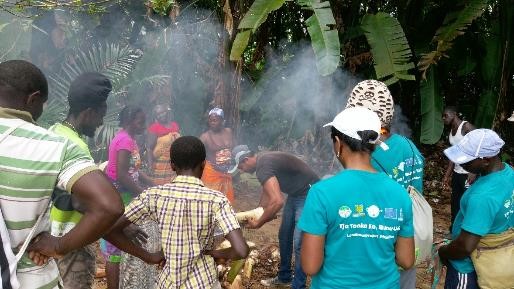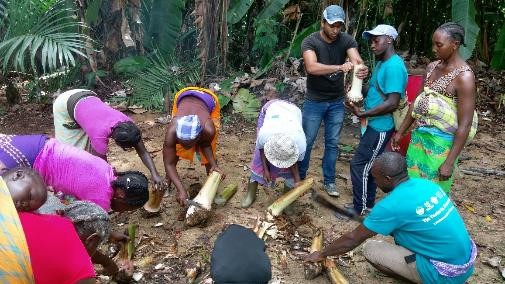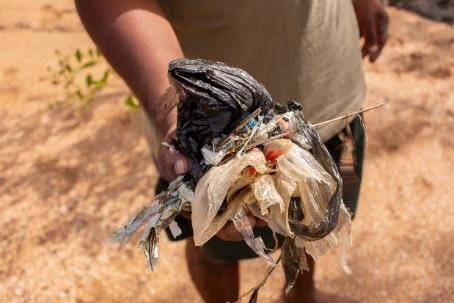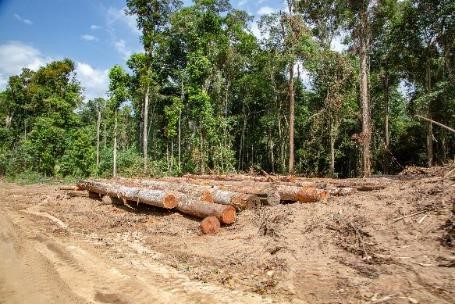Pikin Slee, Suriname. Agroforestry techniques have been taught to the local community through training and field supervision. This is a training course in clean banana plant material production, which is part of a Global Climate Change Alliance Plus (GCCA+), Participatory mapping, ecosystem service assessment, and resilience against climate change project. Photo Credit: © GCCA+/EU 2018. Photo taken by UNDP Suriname/ GCCA+ project in 2018.
The impact of climate change on ecosystems and people
The environment includes the living and nonliving things that an organism interacts with, or has an effect on. Living elements that an organism interacts with are known as biotic elements, these are animals, plants and humans; abiotic elements are nonliving things which include air, water, or sunlight.
Ecosystems are made up of the biological (biotic) organisms interacting with their physical (abiotic) environment. Despite all the benefits that nature offers us, our activities are still able to an adverse effect on it, so we humans must try to take actions that limit the negative impact of our actions on the environment.
Our planet Earth is constantly changing, the land, the oceans, the atmosphere, the climate, and life on Earth have always been subject to change as more and more greenhouse gases are released into the air. Modern science and technology enable people to change their own living environment in countless ways and on an unprecedented scale. We are constantly discovering, inventing, and creating the best, just to have the opportunity to provide the benefits of development, and the opportunities to improve the quality of our luxurious life, although we also have the ability to protect our environment.
The protection and improvement of that environment is a major challenge and has an impact on human well-being and on economic development worldwide. For encouraging worldwide awareness and action to protect our environment, 'World Environment Day' has been established and calls for responsible behavior by everyone in preserving and improving the environment. The theme for World Environment Day 2021 is “Ecosystem Restoration”.
Pikin Slee, Suriname. Agroforestry techniques have been taught to the local community through training and field supervision. This is a training course in clean banana plant material production, which is part of a Global Climate Change Alliance Plus (GCCA+), Participatory mapping, ecosystem service assessment, and resilience against climate change project. Photo Credit: © GCCA+/EU 2018: Photo taken by UNDP Suriname/ GCCA+ project in 2018.
Why do we say that humans influence the change in their own living environment?
Today, when people speak about climate change, they always refer to global warming. Since the industrial revolution, humanity has emitted high levels of CO2 (carbon dioxide, the main molecule and driver of climate change) and other greenhouse gases mostly through burning of fossil fuels.
The elevated levels of greenhouse gases means that due to the presence of certain gasses, heat is retained in the atmosphere for longer periods of time, causing temperatures to rise, in the same way that a greenhouse works for a vegetable garden. Hence the name “greenhouse gasses”. Deforestation is also a major contributor to climate change. When trees grow, they absorb CO2 from the air. When the trees are felled, this CO2 is largely released back into the air. Oceans also contribute to regulating the global climate as they contribute to temperature regulation, impact the weather, influence rainfall patterns, droughts, and floods. Oceans are the world’s largest store of carbon, where the global carbon cycle is circulated through marine waters, and they form a “sink” for CO2. Fortunately for us, Suriname is a High Forest Low Deforestation (HFLD) Country, so the deforestation rate is very low, and we can boast a forest cover of 93 % making us one of the greenest countries in the world.
Global warming has major impact for both people and the environment. Ecosystems, for example, are beginning to shift and it is still questionable whether plants and animals can keep up with these rapidly changing conditions. This leads to the extinction of many species. Agricultural activities for food production
Nickerie, Suriname. David, a volunteer, removing the plastic and other materials stuck on the mangrove plants, as part of a Global Climate Change Alliance Plus (GCCA+) Mangrove Rehabilitation project in Suriname. Photo Credit: © GCCA+/EU 2020. Photo taken by Harvey Lisse. February 2020
are also affected by excessive heat, drought, and extreme rainfall. As a result, there is less yield which can lead to hunger and poverty.[1]
To help mitigate and adapt to the effects of climate change and raise awareness among the Surinamese community, the Global Climate Change Alliance Suriname Adaptation Project (GCCA + Project), funded by the European Union (EU), in partnership with United Nations Development Programme (UNDP), supported the “Participatory mapping, ecosystem service assessment, and resilience against climate change,” project from May 2017 – December 2018. This project was coordinated and executed by Tropenbos International (TBI) Suriname in collaboration with the Center for Agricultural Research in Suriname (CELOS). The goal of this project was to enhance the community-ecosystem resilience to the effects of climate change and to achieve sustainable agricultural development by designing and implementing sustainable, agricultural production systems, in Pikin Slee, (an upper Suriname River area).
A milestone of this project is the agroforestry demonstration plot that has been set up together with local participants from Pikin Slee. For this system trees and woody crops (perennial crops) are combined with annual crops (such as vegetables and fruits). This mixed cultivation enhanced the efficient use of ecological resources (water, light, and nutrients) whereby the above and underground resilience of the agricultural system is strengthened and can contribute to climate change adaptation.
Pusugrunu, Suriname. Tree trunks can be seen on the side of the road, cut down by the logging companies working in this part of the forest. This was discovered during the forest monitoring work of the Forest Rangers, which is part of the Global Climate Change Alliance Plus (GCCA+) Forest Conservation project in Suriname. Photo Credit: © GCCA+/EU 2020. Photo taken by Harvey Lisse. February 2020
This resulting agriculture practice is an alternative for the ‘shifting cultivation’ and a way to bridge the occurrence of persistent drought. Local participants showed the intention to apply the acquired knowledge to their own agricultural plot. This methodology also allows ecosystem restoration as it supports the preservation and protection of forests, meet the needs of the local community, and promotes good management of age-old tropical forests.[2]
During the evaluation of the project, the participants enthusiastically indicated that “the training, has given us knowledge to improve our method of farming in a way that it will be sustainable for future generations.”
Ecosystem restoration means preventing, halting, and recovering of the of ecosystems that have been degraded or destroyed – to go from exploiting nature to healing it. Only with healthy ecosystems can we enhance people’s livelihoods, counteract climate change, and stop the collapse of biodiversity.
Ecosystem restoration can take many forms: growing trees, greening cities, rewilding gardens or cleaning up rivers and coastal areas.
So let us start with ourselves, where we can all contribute in daily life.
When it comes to putting in practice the love for our wonderful planet and its beautiful inhabitants, we would obediently bring our own shopping bag to the supermarket,
Or if everyone deposits their own waste in the designated waste bins and not throwing it on the streets,
Or do we prefer to drink from our own drinking can than plastic bottles,
Or do not take a shower longer than necessary,
Or use our backyard for growing plants, because with more trees or plants in the garden, the rainwater can be collected, which ensures cooling,
Or think carefully if we prefer to take the bike or walk, rather than take the car to the shop on the corner.
After all, we love nature and want future generations to be able to enjoy it too. Nature gives us so much, so is it not time we started giving something back?
[2] GCCA+ Project Documentation February 2019: “Participatory mapping, ecosystem service assessment, and resilience against climate change”

 Locations
Locations


